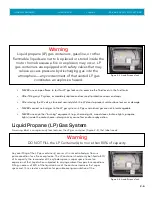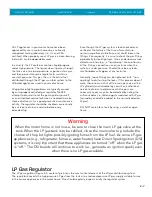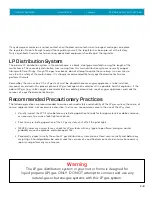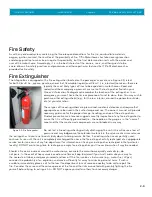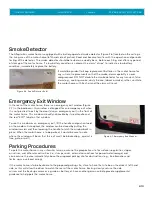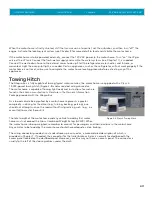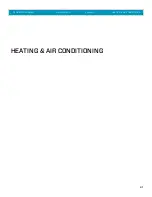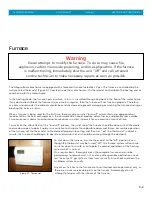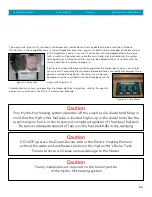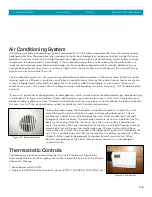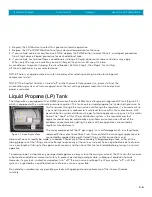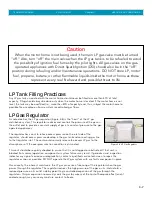
TIFFIN MOTORHOMES
–ALLEGRO BUS®
Chapter 2
DRIVING & SAFETY INSTRUCTIONS
2-3
• In the majority of states, it is the law that seat belts must be used (fastened snugly about the chest
and hip areas), anytime the motor home is in motion, to provide desired protection in the event
of a crash.
• Any fire extinguisher(s) should be inspected on a monthly basis to assure that each extinguisher is
properly charged and ready for operation.
• Any smoke and/or carbon-monoxide (CO)/liquid propane (LP) gas alarm(s) should be regularly inspected and
tested. If being used for the first time, the smoke and/or CO alarm should be properly activated and fresh
batteries installed before the motor home is placed into service. Prior to any trip, the smoke and/or CO/LP
gas alarm(s) should be manually tested to assure their correct operation. Immediately replace any defective
components (e.g., weak batteries). Never sleep in a motor home not having functional smoke and/or CO/LP
gas alarm(s). Should an alarm or detector fail when in transit, a suitable replacement can be purchased at most
hardware stores, superstores, or drug stores.
• While the motor home is moving, the sleeping facilities are not to be used.
• In the event of an emergency, be sure that everyone in the motor home is familiar with all escape exits
(doors, escape window). Do not use the emergency window as a routine exit; this is strictly to be used for
emergency purposes only. When the motor home is parked, be sure that the emergency exits are not
inadvertently blocked.
Prior to Departure
For your continued safety and convenience, the following is a representative “check list” designed to
assure your safety while driving:
• Clean all windows, mirrors, and light lenses (front, back, side) to assure that you can “see” and “be seen.”
Reposition any mirrors or other fixtures to provide an unobstructed view (front, sides, and back) from the
driver’s seat (see Chapter 9 for details). When another driver takes over, reposition the mirrors and other
fixtures for that driver.
• Remove or secure all loose exterior fixtures (e.g., awnings, flags, antennas, portable lights) to keep
them from falling from the motor home when the motor home is in motion.
• Make a “walk-around” visual inspection of the motor home to note any irregularities (e.g., loose
trim) or problems (e.g., under/over inflated tires; abrasions or nicks on the tires); correct noted
problems accordingly.
• Check all exterior storage-compartment and generator-compartment doors to make sure that they are
properly latched and locked. If need be, check inside all exterior compartments to make sure that all cargo
and equipment are properly secured so that they won’t work loose and become hazards during sudden
starts and stops.
Summary of Contents for 2014 Allegro Bus
Page 6: ... TIFFIN MOTORHOMES ALLEGRO BUS Chapter 1 GENERAL INFORMATION GENERAL INFORMATION 1 1 ...
Page 51: ... TIFFIN MOTORHOMES ALLEGRO BUS Chapter 5 CABINETS FURNITURE CABINETS FURNITURE 5 1 ...
Page 55: ... TIFFIN MOTORHOMES ALLEGRO BUS Chapter 6 STRUCTURAL FEATURES STRUCTURAL FEATURES 6 1 ...
Page 57: ... TIFFIN MOTORHOMES ALLEGRO BUS Chapter 7 ELECTRICAL FEATURES ELECTRICAL FEATURES 7 1 ...
Page 72: ... TIFFIN MOTORHOMES ALLEGRO BUS Chapter 8 SLIDE OUT FEATURES SLIDE OUT FEATURES 8 1 ...
Page 76: ... TIFFIN MOTORHOMES ALLEGRO BUS Chapter 9 EXTERIOR FEATURES EXTERIOR FEATURES 9 1 ...
Page 83: ... TIFFIN MOTORHOMES ALLEGRO BUS Chapter 10 INTERIOR FEATURES INTERIOR FEATURES 10 1 ...
Page 87: ... TIFFIN MOTORHOMES ALLEGRO BUS Chapter 11 PLUMBING BATH FIXTURES PLUMBING BATH FIXTURES 11 1 ...
Page 105: ... TIFFIN MOTORHOMES ALLEGRO BUS Chapter 13 ROUTINE MAINTENANCE ROUTINE MAINTENANCE 13 1 ...


















